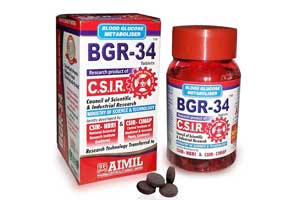- Home
- Editorial
- News
- Practice Guidelines
- Anesthesiology Guidelines
- Cancer Guidelines
- Cardiac Sciences Guidelines
- Critical Care Guidelines
- Dentistry Guidelines
- Dermatology Guidelines
- Diabetes and Endo Guidelines
- Diagnostics Guidelines
- ENT Guidelines
- Featured Practice Guidelines
- Gastroenterology Guidelines
- Geriatrics Guidelines
- Medicine Guidelines
- Nephrology Guidelines
- Neurosciences Guidelines
- Obs and Gynae Guidelines
- Ophthalmology Guidelines
- Orthopaedics Guidelines
- Paediatrics Guidelines
- Psychiatry Guidelines
- Pulmonology Guidelines
- Radiology Guidelines
- Surgery Guidelines
- Urology Guidelines
Herbal drug BGR-34 helps cutting down heart attack risk: study

A study published in an international journal has noted that ayurvedic drug, BGR-34, has been found to be effective in cutting down heart attacks by 50 percent in diabetic patients.
It also found that glycosylated haemoglobin level, tested to monitor the long-term control of diabetes mellitus, or at least half of the patients who had participated in the clinical trial for the herbal drug was under control, said a government official.
The results hold importance given that achieving near-normal glycated hemoglobin (HbA1c) significantly decreases the risk of microvascular and macrovascular complications causing organ and tissue damage, the official said.
Glycosylated hemoglobin is the hemoglobin in the Red Blood Cells (RBCs) to which glucose is bound.
The study was published in the Journal of Traditional and Complementary Medicine.
As per the study, the clinical trial of the anti-diabetic potential of BGR-34 was conducted as per the Indian Council of Medical Research (ICMR) guidelines on conducting trials of ayurvedic substances.
The drug was jointly developed by two CSIR laboratories, National Botanical Research Institute (NBRI) and Central Institute for Medicinal and Aromatic Plant (CIMAP), the official said.
The study noted that though there are many allopathic drugs which were found effective in controlling blood glucose level, these did not prevent all the complications of diabetes.
In contrast, BGR-34 was an appropriate option to consider in addition to a managed care drug formulary, said the study conducted by a group of doctors on around 56 patients in a Delhi hospital.
The polyherbal ayurvedic blood glucose regulator was prepared from six medicinal plants viz. Daruharidra, Giloy, Vijaysar, Gudmar, Manjeestha, and Methi.
The intake of BGR-34 collectively releases 34 active phytoconstituents in the recipient body that helps manage the sugar level in the blood, it said.
According to the official WHO data, India tops the list of countries with the highest number of diabetics followed by China, America, Indonesia, Japan, Pakistan, Russia, Brazil, Italy and Bangladesh.
From 31.7 million in 2000, diabetes cases are expected to rise by more than 100 percent in the year 2030 to account for a whopping 79.4 million.

Disclaimer: This site is primarily intended for healthcare professionals. Any content/information on this website does not replace the advice of medical and/or health professionals and should not be construed as medical/diagnostic advice/endorsement or prescription. Use of this site is subject to our terms of use, privacy policy, advertisement policy. © 2020 Minerva Medical Treatment Pvt Ltd